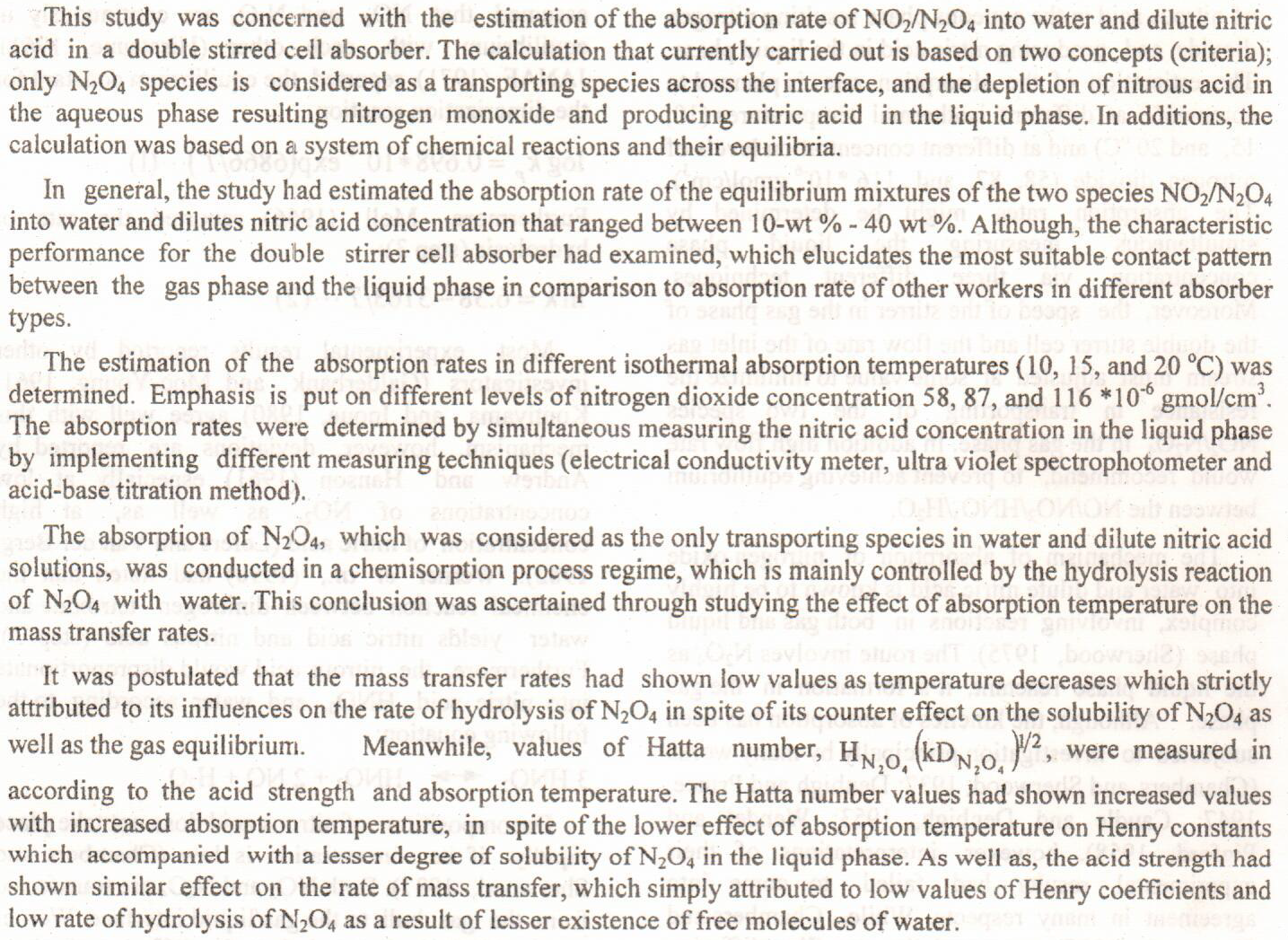
Apparent molar volume, V?, and viscosity B-coefficient of nicotinc acid in water and in aqueous NaCl solutions have been determined from density and viscosity measurements at (293.15, 298.15, 303.15 and 308.15) K. The experimental density data were evaluated by Masson equation, and the derived, apparent molar volume at infinite dilution, Vo?, and the slope Sv, were interpreted in term of solute-solvent and solute- solute interactions. Transfer apparent molar volumes at infinite dilution of nicotinic acid from water to NaCl solutions at various temperatures have been calculated.The viscosity data have been analyzed using Jones-Dole equation, and the derived parameters, Jones-Dolecoefficient, B,and Falkenhagen coefficient,A, have been also in
... Show MoreThe purpose of this research was to evaluate rice husk functionalized with Mg-Fe-layered double hydroxide (RH-Mg/Fe-LDH) as an adsorbent for the removal of meropenem antibiotic (MA) from an aqueous solution. Several batch experiments were undertaken using various conditions. Based on the results, the optimal Mg/Fe-LDH adsorbent with a pH of 9 and an M2+/M3+ ratio of 0.5 was associated with the lowest particle size (specifically. 11.1 nm). The Langmuir and Freundlich models were consistent with the experimental isotherm data (R2 was 0.984 and 0.993, respectively), and MA’s highest equilibrium adsorption capacity was 43.3 mg/g. Additionally, the second-order model was consistent with the adsorption kinetic results.
 (14)
(14)
This research aimed to examine the effect of concentration of dyes stuff, contact time, temperature and ratio of adsorbent weight in (gm) to volume of solution in (ml) on the percentage removal. Two dyes were used; direct blue 6 and direct yellow and the adsorbent was the maize cob. Batch experiments were performed by contacting different weights of adsorbent with 50 ml of solution of desired concentration with continuous stirring at various temperatures. The percentage of removal was calculated and the maximum percentage of removal was 80%. And as the concentration of solution, contact time, temperature and the ratio of adsorbent to volume of solution increase the percentage of removal increase.
Double hydrothermal method was used to prepare nano gamma alumina using aluminum nitrate nano hydrate and sodium aluminate as an aluminum source, CTAB (cetyltrimethylammonium bromide) as surfactant, and variable acids: weak acids like; citric, and acitic acids, and strong acids like; hydrochloric and nitric acids as a bridge between aluminum salts and surfactant. Different crystallization times 12, 24, 48, and 72 hrs were applied. All the batches were prepared at pH equals to 9. XRD diffraction technique was used to investigate the crystalline nano gamma alumina pure from surfactant. N2 adsorption-desorption (BET) was used to measure the surface area and pore volume of the prepared nano alumina, the average p
... Show MoreThe corrosion behavior of carbon steel at different Temperatures and in water containing different sodium chloride
concentrations under 3 bar pressure has been investigated using weight loss method . The carbon steel specimens were
immersed in water containing (100,400,700,1000PPM) of NaCl solution and under temperature was increased from
(90-120ºC) under pressures of 3 bar. The results of this investigation indicated that corrosion rate increased with NaCl
concentrations and Temperature.
Aluminum oxide (ALO) was grafted by acrylic acid monomer (AlO-AM) and then, it was polymerized to produce alumina grafted poly(acrylic acid) (AlO-AP). The prepared AlO-AM and AlO-AP were characterized by Fourier-transform infrared, differential scanning calorimetry , thermogravemetric analyzer and particle size distribution. Adsorption equilibrium isotherms, adsorption kinetics and thermodynamic studies of the batch adsorption process were used to examine the fundamental adsorption properties of phenol (P) and p-chlorophenol (PCP). The experimental equilibrium adsorption data were analyzed by three widely used two-parameters Langmuir, Freundlich and DubininRadushkevich isotherms. The maximum P and PCP adsorption capacities based on t
... Show More (10)
(10)
Abstract This study investigated the treatment of textile wastewater contaminated with Acid Black 210 dye (AB210) using zinc oxide nanoparticles (ZnO NPs) through adsorption and photocatalytic techniques. ZnO NPs were synthesized using a green synthesis process involving eucalyptus leaves as reducing and capping agents. The synthesized ZnO NPs were characterized using UV-Vis spectroscopy, SEM, EDAX, XRD, BET, Zeta potential, and FTIR techniques. The BET analysis revealed a specific surface area and total pore volume of 26.318 m2/g. SEM images confirmed the crystalline and spherical nature of the particles, with a particle size of 73.4 nm. A photoreactor was designed to facilitate the photo-degradation process. The study investigated the inf
... Show More (11)
(11)
 (3)
(3)
This study is an attempt to find whether arginine metabolism dysregulation by arginase activity is related to hyperglycemia, followed by changes in nitric oxide (NO) generation in type 2 diabetic patients. This study includes 42 control subjects (Group I), and 92 Iraqi patients with type 2 diabetes mellitus (T2DM). The patient group was subdivided into two groups: Group II (54) with T2DM only and Group III (38) with T2DM and dyslipidemia (who were treating with atorvastatin along with diabetes treatment). The samples were obtained to measure arginase activity and NO levels. Serum arginase activity increased significantly in patients(groupII and groupIII) compared to control group. While serum NO level was significantly lower in diabetic pa
... Show More (17)
(17)
 (4)
(4)
Single Walled Carbon nanotubes (SWCNTs), as nano-needle structures, are good candidates as nanocarrier delivery systems that carry drug to the site of action. They are good due to their unique pharmaceutical properties. Teniposide is an anticancer drug, which is widely used, but it has a problem of low solubility. In this study, to improve the properties of carbon nanotubes, pre-functionalization of carbon nanotubes via carboxylation with strong acids has been performed and then functionalized through attaching them to the polymer and copolymer. Concurrently, a proper polymer-copolymer combination has been selected by the UV-Visible spectrometer at 880nm. It is selected based on the qualitative dispersibility analysis, the visual observa
... Show More